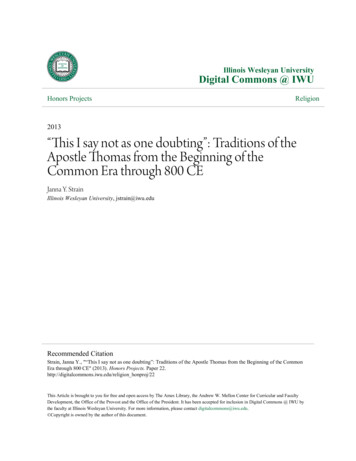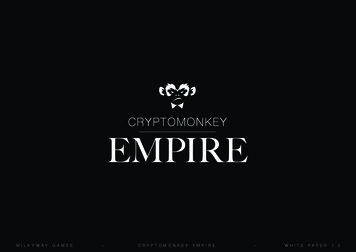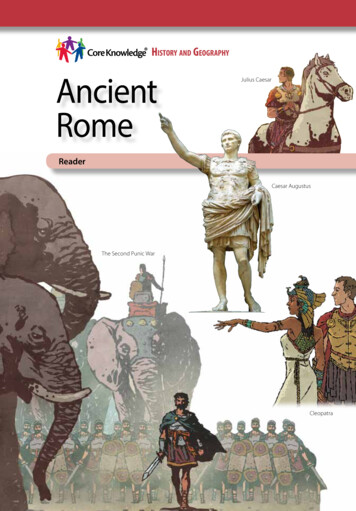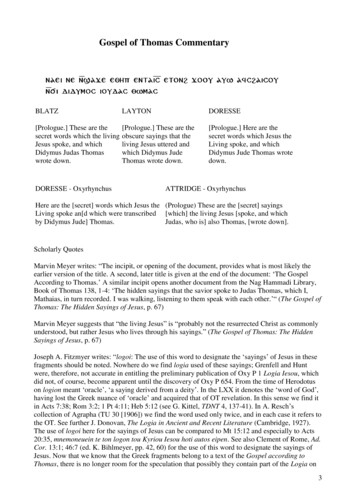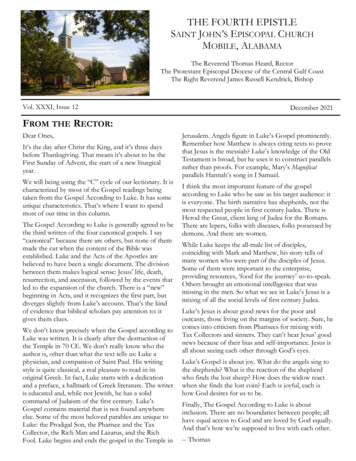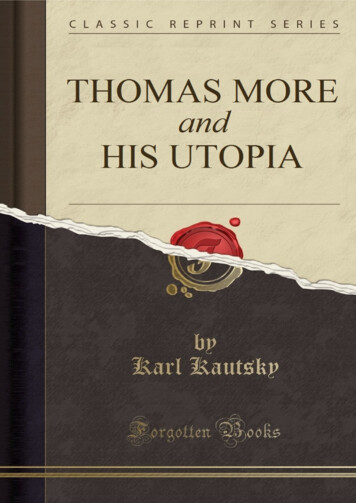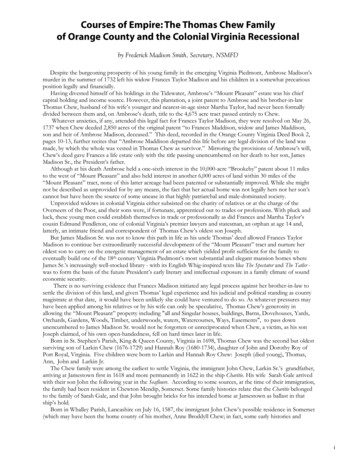
Transcription
Courses of Empire: The Thomas Chew Familyof Orange County and the Colonial Virginia Recessionalby Frederick Madison Smith, Secretary, NSMFDDespite the burgeoning prosperity of his young family in the emerging Virginia Piedmont, Ambrose Madison’smurder in the summer of 1732 left his widow Frances Taylor Madison and his children in a somewhat precariousposition legally and financially.Having divested himself of his holdings in the Tidewater, Ambrose’s “Mount Pleasant” estate was his chiefcapital holding and income source. However, this plantation, a joint patent to Ambrose and his brother-in-lawThomas Chew, husband of his wife’s younger and nearest-in-age sister Martha Taylor, had never been formallydivided between them and, on Ambrose’s death, title to the 4,675 acre tract passed entirely to Chew.Whatever anxieties, if any, attended this legal fact for Frances Taylor Madison, they were resolved on May 26,1737 when Chew deeded 2,850 acres of the original patent “to Frances Maddison, widow and James Maddison,son and heir of Ambrose Madison, deceased.” This deed, recorded in the Orange County Virginia Deed Book 2,pages 10-13, further recites that “Ambrose Maddison departed this life before any legal division of the land wasmade, by which the whole was vested in Thomas Chew as survivor.” Mirroring the provisions of Ambrose’s will,Chew’s deed gave Frances a life estate only with the title passing unencumbered on her death to her son, JamesMadison Sr., the President’s father.Although at his death Ambrose held a one-sixth interest in the 10,000-acre “Brookeby” patent about 11 milesto the west of “Mount Pleasant” and also held interest in another 6,000 acres of land within 30 miles of the“Mount Pleasant” tract, none of this latter acreage had been patented or substantially improved. While she mightnot be described as unprovided for by any means, the fact that her actual home was not legally hers nor her son’scannot but have been the source of some unease in that highly patriarchal and male-dominated society.Unprovided widows in colonial Virginia either subsisted on the charity of relatives or at the charge of theOverseers of the Poor, and their sons were, if fortunate, apprenticed out to trades or professions. With pluck andluck, these young men could establish themselves in trade or professionally as did Frances and Martha Taylor’scousin Edmund Pendleton, one of colonial Virginia’s premier lawyers and statesman, an orphan at age 14 and,latterly, an intimate friend and correspondent of Thomas Chew’s oldest son Joseph.But James Madison Sr. was not to know this path in life as his uncle Thomas’ deed allowed Frances TaylorMadison to continue her extraordinarily successful development of the “Mount Pleasant” tract and nurture heroldest son to carry on the energetic management of an estate which yielded profit sufficient for the family toeventually build one of the 18th century Virginia Piedmont’s most substantial and elegant mansion homes whereJames Sr.’s increasingly well-stocked library - with its English Whig-inspired texts like The Spectator and The Tatler was to form the basis of the future President’s early literary and intellectual exposure in a family climate of soundeconomic security.There is no surviving evidence that Frances Madison initiated any legal process against her brother-in-law tosettle the division of this land, and given Thomas’ legal experience and his judicial and political standing as countymagistrate at that date, it would have been unlikely she could have ventured to do so. As whatever pressures mayhave been applied among his relatives or by his wife can only be speculative, Thomas Chew’s generosity inallowing the “Mount Pleasant” property including "all and Singular houses, buildings, Barns, Dovehouses, Yards,Orchards, Gardens, Woods, Timber, underwoods, waters, Watercourses, Ways, Easements", to pass downunencumbered to James Madison Sr. would not be forgotten or unreciprocated when Chew, a victim, as his sonJoseph claimed, of his own open-handedness, fell on hard times later in life.Born in St. Stephen’s Parish, King & Queen County, Virginia in 1698, Thomas Chew was the second but oldestsurviving son of Larkin Chew (1676-1729) and Hannah Roy (1680-1734), daughter of John and Dorothy Roy ofPort Royal, Virginia. Five children were born to Larkin and Hannah Roy Chew: Joseph (died young), Thomas,Ann, John and Larkin Jr.The Chew family were among the earliest to settle Virginia, the immigrant John Chew, Larkin Sr.’s grandfather,arriving at Jamestown first in 1618 and more permanently in 1622 in the ship Charitie. His wife Sarah Gale arrivedwith their son John the following year in the Seafloure. According to some sources, at the time of their immigration,the family had been resident in Chewton Mendip, Somerset. Some family histories relate that the Charitie belongedto the family of Sarah Gale, and that John brought bricks for his intended home at Jamestown as ballast in thatship’s hold.Born in Whalley Parish, Lancashire on July 16, 1587, the immigrant John Chew’s possible residence in Somerset(which may have been the home county of his mother, Anne Broddyll Chew; in fact, some early histories andi
genealogies placed John’s birth in Chewton Mendip) would have put him in contact with the significant promotersof the Virginia colony based in the West Country of England. According to Thomas Chew’s son Joseph, SirWilliam Berkeley, the Somerset-born Royalist Governor whose administration molded colonial Virginia into itsmost lasting and defining forms, had a “particular regard” for John who was described by another governor, SirJohn Harvey, as “one of the ablest merchants in Virginia” in 1624.Burgess for Hogg Island (1623-39), Burgess from York County (1632-44) and Justice of York (1634-52), John’srising prosperity coincided with Berkeley’s promotion of Virginia as a Cavalier refuge from England’s Civil Warduring his first administration of 1642-52.An historical marker placed in the Jamestown National Historic Site relates that:John Chew, like several of his immediate neighbors, was a merchant,one of the oldest in the Colony. He acquired the small plot here “backstreet”in 1624, and put up a ‘house by him now erected and builded in Newtownewithin the precincts of James City.’The historian Philip Bruce, in his The Social Life of Virginia in the Seventeenth Century, notes that in “the early history ofthe Colony, merchant planters in many instances had residences and storehouses at Jamestown while holding andcultivating large estates elsewhere; this was the case with John Chew” who kept his plantation home on HoggIsland:Among those engaged in business in Virginia, at a very early date . . . wereGeorge Menifie, John Chew and Abraham Piersey . . . . All three rose to wealthand prominence in the Colony and at least one, Chew, founded a familyof distinction and influence.Following the death of his first wife, John remarried in 1651 to Rachel Constable, younger sister of AnneConstable Lee, the wife of the immigrant Richard Lee, founder of the Lee family in Virginia and Rachel’s guardianat the time of her marriage. According to some genealogists, Rachel Constable’s family were also from ChewtonMendip.The Chew House, or “Cliveden,”in Germantown, Philadelphia wasbuilt between 1763-67 byPennsylvania Chief JusticeBenjamin Chew, second cousin ofThomas Chew, and remained inthe family for seven generationsbefore being donated to TheNational Trust in 1972. Site ofthe Battle of Germantown inOctober 1777, the ashlar stonehome is considered one of the mostelegant and architecturally significant Philadelphia Georgian buildings and houses one of the country’smost important collections of highstyle colonial decorative arts andfurnishings.Sometime around 1644, at the time of the Second Indian Uprising, John removed his family to Ann ArundelCounty, Maryland in spite of Berkeley’s attempts to dissuade him. Although John returned to Virginia after thedeath of his second wife, his oldest son Samuel (1634-76) remained in Maryland, residing at his estate“Herrington” at Herring Bay Calvert County. Married to Ann Ayers of Nansemond County, Virginia in 1658,Samuel, a physician by profession, served as a burgess in the Maryland assembly, colonel of the Provincial Forces,Chancellor and Secretary of the Province and was appointed to Maryland’s upper legislative chamber, theGovernor’s Council, in 1669, an appointment he retained until his death. From Samuel and Ann Ayers Chew weredescended the Chews of Philadelphia, most notable among whom were the Chief Justice of the Province ofPennsylvania, Judge Benjamin Chew (1722-1810) builder of “Cliveden”. Samuel’s younger brother Joseph, whoalso lived in Maryland, and his wife Ruth Larkin of Annapolis were the parents of Larkin Chew Sr. Sometimebefore 1700, this Joseph returned to Virginia where he died in 1716 in what would later become SpotsylvaniaCounty.2ii
Larkin Chew Sr. was one of the original burgesses (1723-26) for Spotsylvania County, one of the “mothercounties” of Orange, and patented acreage not only in these counties, but on what were then the far frontier landsof the Valley as well. A vestryman of St. George’s Parish, “Gentleman Justice” and sheriff of Spotsylvania, LarkinSr. apparently arranged for patents to be issued in 1726 to his three sons Thomas, John and Larkin Jr. for lands inwhat later became Orange County.Larkin Sr. was not averse to controversy or litigiousness and, as burgess, was embroiled in legislative disputeswith his one-time friend Governor Alexander Spottswood in the 1726 and 1728 sessions of the General Assemblyover the site of a new town below the falls of the Rappahannock which later became the city of Fredericksburg.One of the original patentees from the colony of a 26,000 acre tract of land in the Great Valley, Larkin Sr.’s Valleyclaims were at odds with those of Thomas, Sixth Baron Fairfax, owner of the vast, 15-million acre FairfaxProprietary, who claimed the right to grant lands in that area as his and not the colony’s, these competing claimsbeing eventually settled by the Privy Council in 1745 which confirmed the land titles of Larkin and others whohad been granted lands by the colony at the same time it confirmed Lord Fairfax’s boundary claims fully to thegreatest extent claimed by him.Described by Lord Fairfax’s biographer, Stuart E. Brown Jr., as a “sophisticated minor capitalist [and]entrepreneur,” Larkin Sr.’s industriousness and enterprise, as revealed in Virginia Council Journals, the officialrecord of the colonial upper house of the General Assembly, merited the comment of the editor of the CouncilJournals for the Virginia Magazine of History and Biography in 1924 who noted that Larkin Sr. “was evidently anenergetic man, a large buyer and seller of lands and with other irons in the fire.”Raised in the Rappahannock Tidewater, a lawyer, justice of the peace and sheriff of Spotsylvania County,Thomas Chew allied himself to the Taylor and Madison families by his marriage in 1724 to Martha Taylor, secondoldest daughter of James Taylor II of “Bloomsbury.” Removing to Orange County in the 1730s, Thomas wasnamed one of “His Majesty’s Gentleman Justices of the Peace” in the original commission establishing OrangeCounty’s courts on January 21, 1735. In his life a vestryman of St. George’s Parish, St. Mark’s Parish and St.Thomas’s Parish, Thomas also served at Captain of the Militia (1729), Magistrate (1734-45) and Sheriff (1745) ofOrange.The eleven children born to Thomas and Martha Taylor Chew were Joseph, Larkin III, Frances, Hannah,Thomas (died young), Coleby, Elizabeth (Betty), Alice, Mildred (Milly), James and Samuel.In addition to his share of the 4,675 acre patent he shared with his brother-in-law Ambrose Madison,Thomas’s additional patent of 1726 in what was later to become Orange County was for over 2,000 acres in thearea of the present day Barboursville and included what later became the Barboursville estate, now theBarboursville Winery. With these two tracts combined, Thomas landholdings in the county would have exceeded3,800 acres in the early 1730s; retaining title to the entire Madison-Chew tract that would later become“Montpelier” on the death of Ambrose Madison would have boosted Thomas’ holdings to over 6,500 acres inOrange. It must have been highly unlikely that Thomas would have alienated his kin or brought harm to the familyof his wife’s nearest sibling by not deeding out the property according to the originally understood division of thejoint patent. Thomas and Ambrose had stood by each other and their father-in-law James Taylor in a protractedlegal challenge to the original survey of their joint patent in the years from 1728 to 1730, continuing their mutualdefense after Taylor’s death in 1729. Family letters, church and christening records attest to the solidarity andcloseness of the Taylor, Chew and Madison families in the ensuing years of the 18th century. Yet, with a growingand substantial family of his own, one might question whether Thomas could have afforded his generosity to hissister-in-law in 1737; there is no record of any regret on his part or the part of his children for his so doing.The Thomas Chew homeplace in Orange County is commonly sited in the vicinity of the present “Woodley”(which it once encompassed), later the home of President Madison’s younger brother Ambrose. Nothing of theoriginal Chew homesite or family cemetery survive, but the location of this home was probably on the hill to theeast of the present U.S. Highway 15 opposite “Woodley” on a site now occupied by a modern subdivision ofhomes.Writing to his son Joseph Jr. in 1797, Joseph Chew stated that “my father, Thomas Chew, once was possessedof a large property which he unfortunately lost in becoming security to two persons for a large amount whofailed.” In typical Old Virginia fashion, Thomas had co-signed notes for his friends, and the fall-out from theirdefault forced him to sell his property to pay these debts.As “Montpelier” historian and archaeologist Thomas C. Chapman notes in his thesis on the Madison familycemetery Who Was Buried in James Madison’s Grave?:3iii
These debts forced Thomas Chew to sell or deed away most of the landhe had acquired during his lifetime, including the original patent land uponwhich he resided with his wife and family. The home tract was deededto Thomas’ son James Chew who lived in Frederick County, Virginia.James held the deed until 1772 when he sold the land to James Madison Sr.The tract of land included most of the original 1723 patent lands. The saleof the land between James Chew and James Madison, Sr. stipulated thata portion would be reserved “to Thomas the enjoyment of the landduring his natural life” and also his wife if he preceded her in death.While Chapman notes that this life estate stipulation in the deed from James Chew to James Madison Sr.“indicates the attachment the Chew family had for the land,” it equally testifies to the due reciprocity James Sr.owed his uncle for the life estate provision made for Frances Taylor Madison in the 1737 deed, and Thomas’securing the title to the “Mount Pleasant”/“Montpelier” property for James Sr. and his descendants at the sametime.The picture of Thomas Chew which survives in the county and Colonial records is of a rather Fieldingesquesquire and gentleman justice unafraid to assert his privileges; in particular, a report to the Virginia House ofBurgesses concerning a contested 1741 election involving Thomas and his in-law Henry Downs Sr. evokesparallels to William Hogarth’s “The Election” series of prints, popular in Anglo-American society of the time,which satirized the high spirits which often attended elections in the 18th century:. . . Mr. Robert Slaughter, Mr. Henry Downs, Mr. Thomas WrightBelfield, Mr. Thomas Chew, Mr. Zachariah Taylor, Mr. WilliamRussell and Mr. James Wood stood Candidates for the Election;and that the poll was opened on Friday the Twentieh Day of Novemberlast, about Twelve of the Clock. That as soon as the poll was opened, JohnMacCoy, Honorious Powell, John Snow, and Timothy Terrill, and severalothers throng’d into the Court-house in a rioutous manner and made sucha disturbance that the Sheriff and Candidates were obliged to go outof the Courthouse, ‘til the House was clear’d, and the People appeas’d:And that the said Mr. Chew, whilst he was on the Bench, called for aBowl of Punch, and had it brought to him; upon which, the Sheriffstay’d the poll, and said he would not have Punch drank on the Bench . . .to which Mr. Chew replied, he would have Punch, and drink of it, andthat the Sheriff should not hinder him.Voting in England and Virginia was a viva voce affair at this time, with the candidates sitting in a row on theraised dais or bench of the courthouse as the freeholders of the county filed in one-by-one to declare their votes inopen court. As such, the election could take hours, a day or several days until the authorities were satisfied that asignificant number of eligible voters had declared their choices.The sheriff’s clearing of the House to “appease the people” was a temporary fix to this impatient and thirstycrowd which later “throng’d into the Court-house in a drunken riotous Manner, one of them jumping upon theClerk’s Table, and dancing among the Papers.” Doubtlessly hoping the crowd’s inability to hold its liquor woulddissipate with a thorough sleep-off, Chew and his fellow candidates asked the sheriff to adjourn the poll andreconvene it the next day.As sheriff of Orange in 1745, Thomas was responsible for supervising the execution of a capital criminal, aslave named Eve, convicted on January 23, 1745 of poisoning her master Peter Montague. The court’s sentencewas “that the said Eve be drawn upon a hurdle to the place of execution and there to be burnt” at the stake, asentence carried out the following week.Under the English statute law of the time, such murders were actually categorized as “petty treason,” a criminalclassification which included patricide, matricide as well as the murdering of masters by slaves or servants. Whilethese sentences may seem harsh even by the standards of the late 18th and early 19th centuries, the prescribedpunishment for crimes of treason, specifically for Grand Treason as noted by Webb’s Virginia Justice andmandated by English law at that date, was hanging, disemboweling, drawing, quartering and nailing of thedismembered body parts to the gibbet or gallows, while the heads of these convicts were to be spiked upon poles.In fact, the year 1745 saw the largest mass execution of such sentences when the Scottish Jacobite rebels defeatedat the Battle of Culloden were summarily beheaded and their heads spiked on poles along the highway fromScotland to London by the General suppressing the rebellion - the Duke of Cumberland, brother of King GeorgeII, afterwards styled “Bloody Cumberland.”4iv
In any event, as President Madison’s biographer Irving Brant notes, Thomas Chew, as the county’s chief lawenforcement and administrative officer, most certainly delegated the hands-on business of carrying out sentencesto the Under Sheriffs in his charge who performed the necessarily dirtier work associated with this office incolonial Virginia.The closely knit social world of the allied gentry families in 18th century Orange County depicted in the Diary ofFrancis “Frank” Taylor, (Martha Taylor Chew’s nephew and son of her brother George Taylor) seems a perennialround of fish fries, balls, dances, barbecues, church-goings and visits to the local springs. As with most ofupperclass Virginia’s endogamous families, the Chews, Taylors, Madisons, Macons, Moores, Lees, Willises,Colemans, Slaughters and Conways of Orange County preserved their bonds of kinship and association not onlyby intermarriage, but an assiduous cultivation of kin-networks by naming cousins as godparents.Three of Thomas and Martha Taylor Chew’s daughters - Hannah, Milly and Alice - were godmothers to severalof Frances Taylor Madison’s grandchildren, including Ambrose Madison, Catlett Madison, Nelly Madison (Hite)and William Madison, all siblings of President Madison. The same daughters would also be godmothers to severalchildren of James Madison Sr.’s sisters Frances and Elizabeth. Further cementing families ties, Thomas andMartha’s daughter Alice in 1796 married her first cousin Zachary Taylor Jr., son of Martha’s brother ZacharyTaylor Sr. and Elizabeth Lee of “Ditchley.” Zachary Jr.’s younger brother Richard would later become the fatherof yet another Zachary, know to history as “Old Rough and Ready,” celebrated General of the Mexican War andthe 12th President of the United States.Hannah never married and, according to her brother Joseph’s correspondence, devoted her life to the care ofher parents, while Mildred married Francis Coleman of Orange.Frances, the oldest daughter, married Henry Downs Jr. of Orange and moved to North Carolina in the 1750s,settling at Providence, Mecklenburg County, near the present city of Charlotte where they raised a family of sixchildren and were prominent in Patriot activities during the Revolution. Henry Jr. was a signer of the MecklenburgDeclaration of Independence, co-founder of Providence Presbyterian Church, Justice of the Peace, Tax Assessorand an Overseer of the Poor for Mecklenburg County. Three of the sons of Henry and Frances Chew Downs Thomas, Samuel and William - served in Carolina Patriot regiments during the Revolution. Henry Jr.’s youngerbrother William Downs, an adjutant colonel in the Continental Army under General Gates, was a charter memberof the Society of the Cincinnati in the State of South Carolina.Two of the younger sons of Thomas and Martha Taylor Chew, Larkin III and Coleby, were active in theVirginia regiments fighting during the French and Indian or Seven Year’s War. Larkin, who never married, servedas a lieutenant in Byrd’s Second Virginia Regiment against the Cherokees and suffered a permanent wound, hisarm being shattered by a musket ball in 1754, while Coleby, an officer in the First Virginia Regiment under GeorgeWashington’s command in 1757-58, served in the second ill-fated British expedition against Fort Duquesne.In December 1762, Larkin III petitioned the House of Burgesses for compensation of the losses he sustained inthe service as well as for paying the debts of his soldier brother Coleby:[A]fter the decease of his Brother Coleby Chew, who had been for someTime in the Service, and who was killed bravely fighting for his Kingand Country near Fort Du Quesne, several Debts due from him, to theAmount of Ȯ22, were proved and demanded of (Larkin), who paidthe same, as he could not think of letting the Memory of a brave Brotherbe degraded with the Reproach of not paying his Debts, though he hadlittle Money to spare himself; that in the Month of May 1759, in anEngagement with the Enemy, he received a Wound in the Elbow Jointof his right Arm, which shattered the Bones thereof . . . .Larkin further recited that at the time of his wounding, the enemy had taken from him two horses, his baggage,clothes and papers including memoranda of money owed him and receipts for those debts of Coleby’s which hehad paid - in all, a sum of Ȯ87. Moreover, Larkin claimed to have spent Ȯ20 for nurses and attendants during hisconvalescence.In response, the Burgesses resolved “that the said Larkin Chew be allowed the sum of Ȯ100, as a Satisfactionfor his Losses, and the Wounds he received in the Service of the Colony; and the Sum of Ȯ40 a Year during hisLife, for the Loss of the Use of his right Arm,” a resolution approved by Governor Fauquier on December 23,1762. This compensation must have been generous - William Byrd III, admittedly one of the colony’s majorgrandees, was granted Ȯ500 with no annuity upon a similar petition for his war losses by the same session of theGeneral Assembly. If this annuity was indeed continued to Larkin until his death in 1796, his total compensationwould have been over Ȯ1,400. (George Washington’s salary in the 1750s as Adjutant of the southern division ofVirginia - the colony’s senior military rank - was Ȯ100 a year; Larkin’s yearly pension would have been almost half5v
this amount.) As Larkin never married and, presumably, lived with his parents and sister Hannah at the homeplace,this annuity must have been one of the family’s main sources of income in later years.Apparently Coleby was taken personally under the wing of then Colonel Washington who recommended himfor promotion in dispatches to Governor Dinwiddie in August of 1757, first as ensign and later, as lieutenant. Thefollowing year, Coleby sent a detailed and prescient report to Washington of a scouting expedition to FortDuquesne in which he described the evidence of “a great many Indians” who had been traveling along the denselyforested route. At one point, as they neared French held territory, the Indian scout guiding Coleby’s partyprepared them against any encounters:[The] Chief Warrior took his conjuring Implements & tyed them abt.the Necks of three young men Indians & told them they could not behurt: Round my Neck he Tyed the Otter Skin in which the ConjuringImplements had been kept & round the Sergeants neck he tyed a Bagof Paint that had been kept with the Implements, he then told us thatnot one of us could be shot for those things would turn the balls from us.He then made us strip ourselves of all our Cloaths except our BreechClouts & mocasons, then shook hands with us & told us to go & fightlike men for nothing could hurt us.Approaching Fort Duquesne in this impenetrable attire, Coleby reported to Washington that he estimatedthere were about 300 Frenchmen in the fort while the number of Indians he estimated from their “continualHooping . . . singing & dancing” as about fifty, identified by his Cherokee guides as “all Shawnees.” (Coleby andhis party were dressed in Indian attire not primarily for reconnaissance, but because the new uniforms for theVirginia Regiment, ordered from England, did not arrive until the following year.)Coleby’s estimate of the route to Fort Duquesne foreshadows the conditions that were to plaque an ultimatelysuccessful attempt in the Autumn of 1758 by British General John Forbes to take that fort, scene of the disastrousdefeat of General Braddock in 1755:The low grounds & branches I mentioned in my Journal as I went towardsFort Duquesne are very low & liable to be overflowed & consequently verymoist & soft so that I am afraid a road through them will be very indifferent forcarriages . . . .This indifferent road also would be the doom of Coleby and many of his fellow Virginia officers in September1758 when an advance party led by Major James Grant of the 77th Highlanders was virtually destroyed attemptingto attack the fort. This force - a mixture from the Highlanders, the 60th Royal American Regiment and the Virginia,Maryland and Pennsylvania Provincial regiments and their Indian scouts - sought on Grant’s initiative and,arguably, contrary to Forbes’ instructions, to draw the French and Indians into a nighttime ambush in the woods infront of Fort Duquesne. Grant, in a report to Gen. Forbes following the battle, said he chose Coleby and 20soldiers to lead a vanguard party to the walls of the fort on the night of September 13 to tempt the enemy into achase back into the woods where Major Lewis of the Virginia Regiment and 200 soldiers lay in wait:I ordered Mr. Chew to march with a party of fifteen or twenty men toreconnoitre the ground and to try, without exposing himself or the men, todraw a party of the enemy into the ambuscade. . . .He only went with threeIndians, who soon left him, and, by that means, in place of returning to MajorLewis about ten o clock as I expected, he was obliged to conceal himself tillnight came on, and he joined me upon the march about eleven o clock at night.But I would not be understood to reflect upon him; he is a good, brisk young lad.Grant, however, had misjudged his distance from the fort which was actually more than 15 miles from Lewis’position rather than the five miles he had originally estimated; once this had been ascertained by Lewis andreported to Grant on September 14, Grant, infuriated by the delay, rushed forward and pushed the night ambushtactic again. In the thick woods and steep inclines of the approaches to the fort, his troops became scattered andlost in the darkness. As they straggled back to the staging area, Grant sought to reorganize his troops by orderinghis Regimental Piper to play. Knowing the bagpipes must have alerted the French and Indians to his presence,Grant was surprised when the forces inside the fort gave no sign of reaction and were, in fact, dead silent.Thinking this a sign the fort was undermanned or cowed, Grant rushed his Highlanders forward into the openplain in front of Fort Duquesne whereupon the French and Indians, some 800 strong, swarmed out and threwthemselves onto Grant’s troops at the same time Indian detachments spread out on the Monongahela andAllegheny rivers to cut off his retreat. The entire battle lasted, according to Grant, less than half an hour andresulted in the loss of over 300 missing, wounded or killed from among his original 400 men; the remainder,6vi
including Grant, surrendered. Coleby, wounded, fell into the Monongahela and was drowned trying to get back toGen. Forbes’ base at Fort Ligonier.When the news of his death reached his oldest brother, then living in New London, Connecticut, JosephChew wrote to Washington on October 11:It is very hard for me to tell you the great uneasiness I have laboured undersince last post - on acct. of the affair near Fort Duquesne where it is said ourTroops commander by Maj. Grant with loss of many Virginians amongstwhom I am informed my poor brother makes one. I pray you my dear friend tolet me know how that matter was and what fate my dear brother met . . .al
This deed, recorde d in the Or ang e Coun ty Virgini a Deed Book 2, pa ge s 10-13, fu rth er r eci te s th a t A m br o se Mad dis on depart ed thi s life before an y legal di vision of the la nd was mad e, b y wh ich th e wh o le w a s


